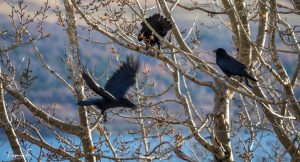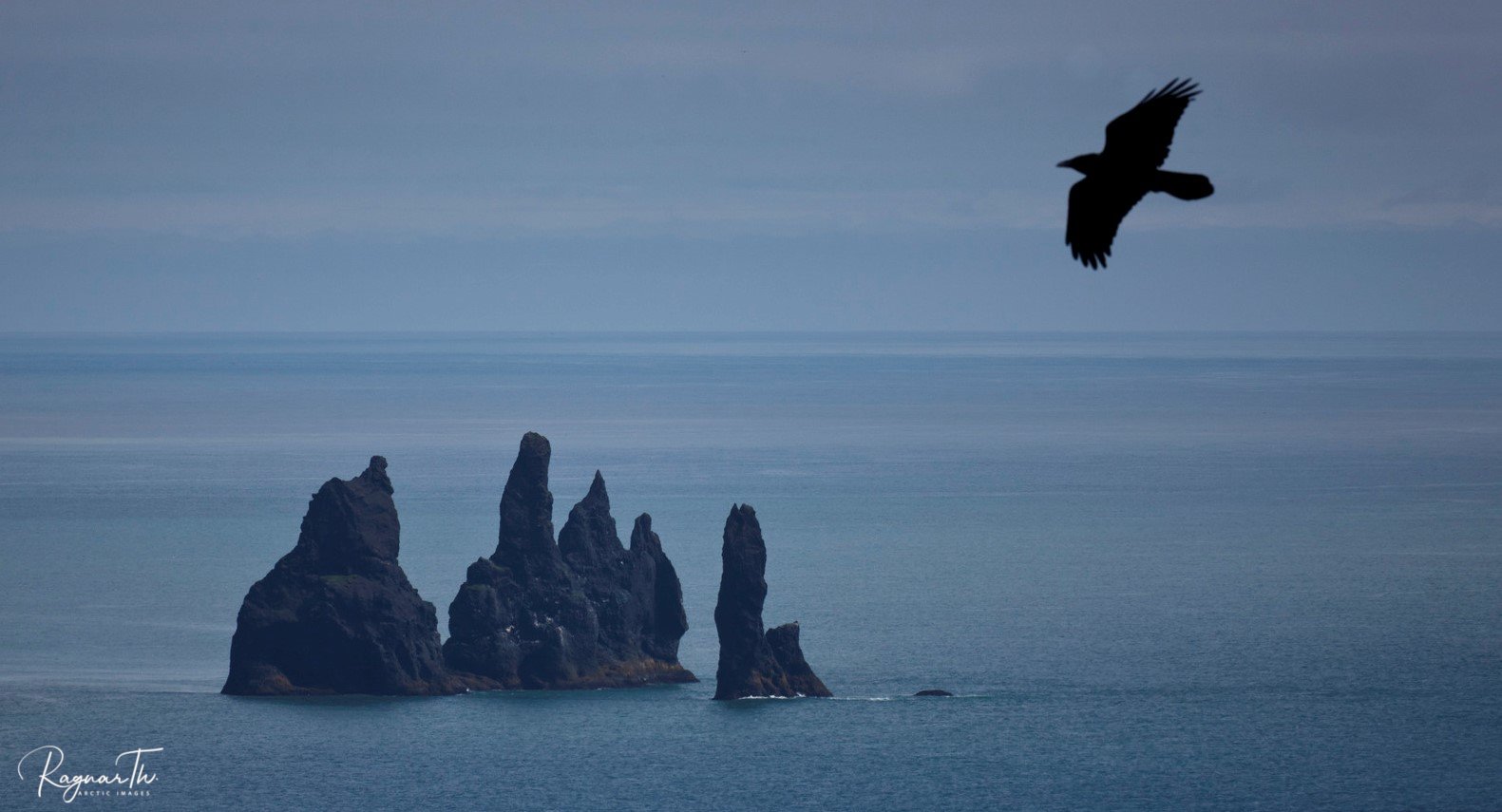This is the Raven
The Common Raven (Corvus corax) is a large passerine bird (Passeriformes) of the Corvidae family, which are all sort of crows. Corvids have been known for their intelligence and problem-solving skills which are often considered as supernatural powers. No wonder that the raven is so popular in stories, legends, and poetry.
The Icelandic word “hermikráka” translates as “mimicking crow”. It refers to the ability of corvids to mimic the sounds of other animals, including humans. You might hear a raven boo, meow or bid a good day! They are often great tricksters and do all sorts of strange activities for their own amusement.
The Looks and Pattern of Life
“Krummi” and “hrafn” are the most used Icelandic words for a raven. This handsome bird is characterized by its jet black color, its size, and a rough croak. The raven is a great acrobat, it can even do rolls and other tricks in the air. It has big powerful wings with a wingspan of 100-150 cm (40-60 in). On the ground, the raven often hops around galloping like other passerines. The raven has strong feet, long claws, and a good grip. Its height is 60-75 cm (24-30 in) and the weight is 1-2 kg (2-4.5 lbs). The male is usually a little bigger than the female.
Ravens live all around the northern hemisphere. They are very resourceful when it comes to feeding and can dwell in the lowlands, close to the sea, as well as in the highlands. Ravens have even been spotted in the Himalayas in Nepal, where they follow mountain climbers. They live all around Iceland and the population is estimated to be 2000-2500 breeding pairs, or 11-13000 birds in late summer.
Five Fun Facts about Ravens
- In nature, most ravens become 10-15 year old but the oldest marked raven lived more than 22 years. Ravens can become much older in captivity. There are stories of ravens turning 69 years old!
- Ravens are great copycats and can learn all kinds of animal sounds. Some have even learned human words.
- Ravens enjoy their playtime. You might see them standing on cans and sliding across frozen lakes or sliding down rooftops, just for the fun of it. Farm dogs and eagles are popular victims of bored ravens who find teasing other animals extremely amusing.
- Ravens are known to be great acrobats. They can do rolls in the air and fly long distances upside down. Two ravens can even lock their claws together and fly as if they were holding hands. Ravens sometimes fly around with sticks or other small objects which they then drop spontaneously from the air and can often catch it again before it hits the ground. This behavior seems to be mostly for fun.
- Falcons often steal the nest of ravens to use as their own. Most falcon pairs in Iceland lay eggs in old raven nests.

Family Life
In Iceland, the raven is one of the first birds to start egglaying in the spring and often starts incubating in early April. When their eggs hatch, other bird species are starting their egglaying. There is, therefore, an abundance of eggs for raven-parents to steal and feed to their young. The raven nest is called “laupur” or “bálkur” in Icelandic and is a remarkable phenomenon. It is a large pile of different sticks and junk that ravens collect in their environment. The raven is known for its love for shiny objects and has a reputation for stealing things that catch its eye. Shiny trinkets, metals, glass, and even feathers or wool are among the things the raven uses to make its nest.
The raven mates for life. A raven couple holds its own territory and fights off other ravens. They lay on average 4-6 eggs each year. The female raven incubates for 20-22 days while the male brings her food and protects their territory against other ravens.
Food and Company
Ravens stay in Iceland all around the year. During the cold winter months, they often stay in towns and around farms searching for something to eat. They are omnivorous opportunists that are not afraid to try new things for dinner. Ravens are very sociable and often sleep together in flocks of tens of birds, in cliffs or ravines. During the nesting period, however, raven couples stay together. Non-breeding ravens often form large flocks of up to a hundred birds. These flocks of non-breeding ravens tend to harass eider colonies, steal their eggs and young, and destroy their nests. Sometimes they even attack newborn lambs or helpless sheep, terrorizing the farmers. Because of ravens’ strong survival instincts, they have often been persecuted.

Ravens in Fables, Anecdotes, and Legends
An old Icelandic legend says that ravens meet twice a year, spring and autumn, at a special congress where they share the latest news and gossip. At the spring congress, the ravens vote on whether they should be naughty or nice to the farmers that summer. At the fall congress, they decide where each raven will stay during the winter; two at each farm. If all but one raven have got a home for the winter by the end of the fall congress, the ravens will kill that last bird.
In Nordic mythology, Odin, the ruler of Aesir, owned two ravens named Huginn and Muninn. These ravens flew around the world, returning to Asgard to whisper news in Odin’s ear. They sat on his shoulders or at his throne, representing wisdom and foretelling abilities. Odinn is therefore known as the “raven-god”, among other names.
Many Norwegians still believe that ravens can predict natural disasters and weather changes and that it is good to pay attention to their behavior and croak. In Iceland, there is a saying that “God rewards those who help the raven”. Because of this, some people feed them during the coldest months of the year.
Ravens played a role in the settlement of Iceland. Raven-Flóki, or “Hrafna-Flóki” in Icelandic, was the first to settle in Iceland. He gave the country its name before Ingólfur Arnarson arrived. Raven-Flóki brought three ravens with him on his ship and as he neared Iceland, he released them to help him navigate. The first raven flew back to Faroe islands and the second one flew straight back to the ship. The last raven showed Flóki the way to Iceland. This is why ravens are often associated with the Icelandic settlement. There is a strong bond between Icelanders and the common raven.
Links Worth Clawing at
- Ravens on Wikipedia
- A better look at the raven at All about Birds
- Listen to the raven on YouTube
- An Icelandic version of this article
Author: Dr. Þórður Örn Kristjánsson
Photographer: Ragnar Th. Sigurðsson

